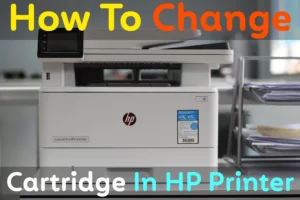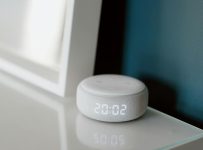
Printers are some of the most impressive creations that most people use in the office or at home, and most people don’t take time to look into how they work. You probably have tech personnel to fix it or replace the toner cartridges.
Sometimes you might not have help, so you need to figure out how to replace the cartridge on your own, and this article will be helpful to you.
Let us get into the details and see the best ways to use and maintain HP printers to get the best service from them;
How To Change Cartridge In HP Printer
Today’s most common type of printer is the LaserJet printer, so this article will primarily focus on replacing its cartridge.
The design is almost similar, and you can use this idea to figure out other printers so let us get into the details;
Before going into cartridge replacements, you need to know when the cartridge has run out of toner.
The printer will prompt an error message on your screen warning you when the ink low and it is time to replace the cartridge.
You will also know the toner cartridge is low when the printout quality deteriorates, or one color doesn’t come out the way it usually does. Here are some simple steps to replace a cartridge, and you don’t need any tools to get through them;
- Lift the scanner assembly, then raise the top cover until you hear it click into place to know it won’t come back down when you let go.
- Hold the middle handle of the toner cartridge, then pull it out while adhering to the tracks to remove it.
- The packaging shell has a release tab; pull it to open the new toner cartridge and take it out of the packaging.
- Hold the new toner cartridge by the handle and align it with your printer’s tracks at the same position you took the used one out. Push it in along the tracks until it clicks into place.
- Close the cover and lower the scanner assembly, and you will be ready to use the printer.
Make sure you dispose of the used cartridge correctly to help manage pollution since the companies can reuse them. The positioning of the cartridges might vary depending on their size and your printer’s model.
The design of some printers allows you to slide them out from the side of the printer and slide the new one in.
Some colored laser printers have an entire tray of cartridges, so you can access the tray and take out the affected color cartridge.
Models like the HP Deskjet 2652 have cartridges below the paper tray and are square. You can refer to your user manual to see exactly how your printer works and how you can replace the cartridge.
Considerations When Replacing Toner Cartridges
For anything to work correctly, you need to take good care of it and maintain it as well as possible, so it is always in exceptional performance.
Knowing the right way to perform said maintenance procedures is crucial since doing it incorrectly could lead to more damage.
One of the most common maintenance practices for a printer is replacing the toner cartridge, particularly crucial for laser printers.
The toner will run low, then at some point, you won’t have any left, and you will need to replace the cartridge.
Look for messages
The printer will usually send you notifications when the toner gets low, so make sure you check the messages to know the time you have before you need to replace it. A notification that the toner is low doesn’t mean you immediately replace it.
The toner could be low, but depending on how you use the printer, you might have weeks before you have to install a new cartridge. Only replace the cartridge if you notice a deterioration in printout quality.
Take care of the OPC.
Most laser printer cartridges also have the Organic Photoconductor drum, which is crucial for the printing process.
So when you replace the cartridge, you are replacing the OPC, and you might damage the drum if you aren’t careful with it during installation.
Laser printers use light for most of their work which means most of their components, including the OPC, are sensitive to light.
You, therefore, need to keep the cartridge inside a bag until it is time to replace it to ensure it doesn’t get damaged.
Power down the printer
You need to add this safety practice to all your electronics to keep you and the equipment safe. Before changing anything, make sure you power down and disconnect the component from the mains power.
Turning it off will ensure you don’t get electric shocks that would otherwise be life-threatening and damage your printer.
Make sure your hands are dry before going into the printer, so you don’t cause a short circuit when you plug it back in.
Remove packaging strips from the cartridge
Toner cartridges are usually modular, and it is easy to remove them and replace them with a new one; just make sure you remove any packaging strips from the new cartridge before installation. These might compromise the fit in the space, and the printer might not work.
If you want to know what to remove and leave, look at the old cartridge and remove any sticker that the new one has, and the old one doesn’t.
While doing this, avoid touching any metallic parts on the cartridge and if you do, wipe it down before installing it.
Laser Printer Maintenance Kits
Laser printers need a lot of attention from the users to work optimally, and you will see a difference in the printout quality if you don’t maintain it properly. You might even have leaks and spills on the paper so let us help you avoid all these issues;
- Laser printers have many moving parts, and as you use them to print more pages, some of these parts will wear out, and the printer’s performance will drop. Some parts deal with a lot of heat and pressure, so you might need to swap them out occasionally to keep the printer working.
Because of this, most manufacturers create a standard maintenance kit that comes with the printer. It will have everything you need to replace during the scheduled maintenance processes. It contains new fuser units, feed rollers, etc.
- The maintenance schedule will depend on the printer’s workload, and most printers have a page counter to help you schedule this maintenance.
A home printer will have a longer time before maintenance since it most likely works less than a printer in a large office building.
- Typically, you will power down the printer, remove the power sources, and replace the components inside the printer.
You can do this yourself if you have the technical skills, but it might be better to have a specialist look at it to avoid damaging the printer.
- You must be careful when replacing the fuser unit since it gets hot when the printer is in use. Therefore to change the fuser unit, turn off the printer, open it up and give it some time to cool off before going in to swap out the parts.
- Once you have replaced the fuser unit and provided any maintenance tasks for the session, you can power on the printer and reset the page counter to schedule the next maintenance session.
- Sometimes you will need to calibrate the printer after maintenance. You should print out a test page after changing the toner cartridge to see if it prints differently from what you had initially.
You can do a laser printer calibration to alter the density of the printouts, so you get the perfect colors.
Some high-end printers will automate this process and don’t need to worry about it, but others may need you to calibrate it manually. Each printer is different, so you should check the user manual for your printer to give it the best service.
- Laser printers get dirty, and sometimes they will have ink droplets and paper dust, affecting the printout quality. You need to clean the printer regularly to maintain its quality.
Check the manufacturer’s instructions for the specific substance to clean the printer. Some use water and others Isopropyl alcohol so refer to the user manual to keep the printer clean and operational.
Don’t use any harsh chemicals like chlorine inside or outside of your printer. A wet cloth will be enough to clean off the toner, and you must avoid using compressed air or vacuum cleaners.
Conclusion
Changing printer cartridges is one of the most straightforward maintenance processes for a printer, and you have to do it eventually. The printers differ in design based on size and model, so you might have to refer to a manual to get specifics on your printer.
It is crucial to take good care of any electronics and replace any of their worn-out parts so the electronics can offer you the best service.


